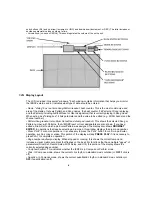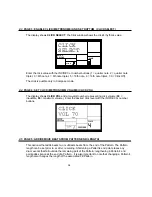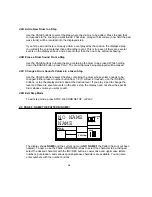
3
STOP or switch over to Perform mode. You will hear any previously-played parts as you record
new parts. You can also erase drum hits while the pattern is looping to correct for errors.
1.2D
What's a Voice?
Each of the 8 large pads triggers a
voice
. A voice is a sound-generating element with several
variable parameters: Drum sound, tuning, volume, output assignment (the voice's audio output
can go to either one of two sets of stereo outputs, and furthermore, to anywhere within the
stereo field of the chosen set of outputs), and MIDI note number.
Each pad is
velocity-sensitive:
the harder you hit the pad, the louder the drum sound assigned
to the pad will play. Thanks to the dynamic articulation techniques mentioned earlier, the
timbre will often change as well, just like "real" drums.
There are eight levels of pad volume resolution, from soft to loud. However, when using the
IED04 as a drum sound expander and triggering sounds via MIDI, they respond to all 127 MIDI
volume levels.
1.2E
About Defaults
A default is a setting that is automatically assumed until you purposely change it.
Example:
When you turn on a VCR, it automatically defaults to Stop—you have to purposely tell the
machine to go into Record or Play. Stop is therefore the VCR's power-up default status.
The IED04 includes a default setup that assigns particular drum sounds to particular voices
(pads), at certain level and pan settings. The default drum sound assignments are explained.
However, you can change these defaults and come up with any type of "drum set" you'd like.
Defaults save time by giving you a setup that's instantly ready to go; sometimes you'll need to
change only a few parameters to customize the default setup to your liking.
Often the default is "whatever was selected last."
Example:
If the IED04 was in Pattern mode
and Pattern 23 was selected when you turned off the IED04, the next time the IED04 powers
up it will be in Pattern mode with Pattern 23 selected.
1.2F
Physical Layout
The IED04 includes seven main types of controls, along with a group of connectors (located on
the back panel). The control groups (see diagram) are:
•
Pads.
Striking each pad triggers an IED04 voice.
•
Function buttons.
These six buttons select various functions, some of which include multiple "pages" of options.
•
Tempo/Page buttons.
These alter the tempo and also select different "pages" present in the Drum Set, Record
Setup, MIDI Setup, and Util functions.
•
Pattern select buttons.
These choose between the A, B, and Fill variations for a Pattern.
•
Mode buttons.
These choose between Pattern and Song modes, Perform (playback) and Compose (record)
modes, and the Preset and User patterns.
•
"Tape recorder" buttons.
These control playback and stop, and work similarly to a tape recorder.
•
Display and data entry buttons.
The display informs you of the instrument's status, and also prompts you for
data from time to time. A detailed description of the display follows shortly. The data entry buttons include number
Summary of Contents for iED004
Page 1: ...Reference Manual iED04 Digital Drum Station...
Page 2: ......


































